SM9677 - Management Strategy: Tesco's Competitive Advantage Analysis
VerifiedAdded on 2023/04/08
|18
|3963
|291
Report
AI Summary
This report provides a comprehensive analysis of Tesco's management strategy, focusing on the opportunities and challenges within the retail sector. It examines Tesco's mission and vision, the influence of its board of directors and stakeholders, and applies strategic tools like Porter's Five Forces and PESTLE to evaluate the company's strategic position. The analysis covers the internal and external factors impacting Tesco's performance, including competitive rivalry, bargaining power of suppliers and customers, and potential threats from new entrants. Furthermore, the report delves into the roles of managers, shareholders, and stakeholders in shaping strategic policies, emphasizing the importance of aligning strategies with customer demands and societal expectations. Ultimately, the report aims to provide insights into enhancing Tesco's competitive advantage through informed strategic decision-making. Desklib provides access to similar past papers and solved assignments for students.
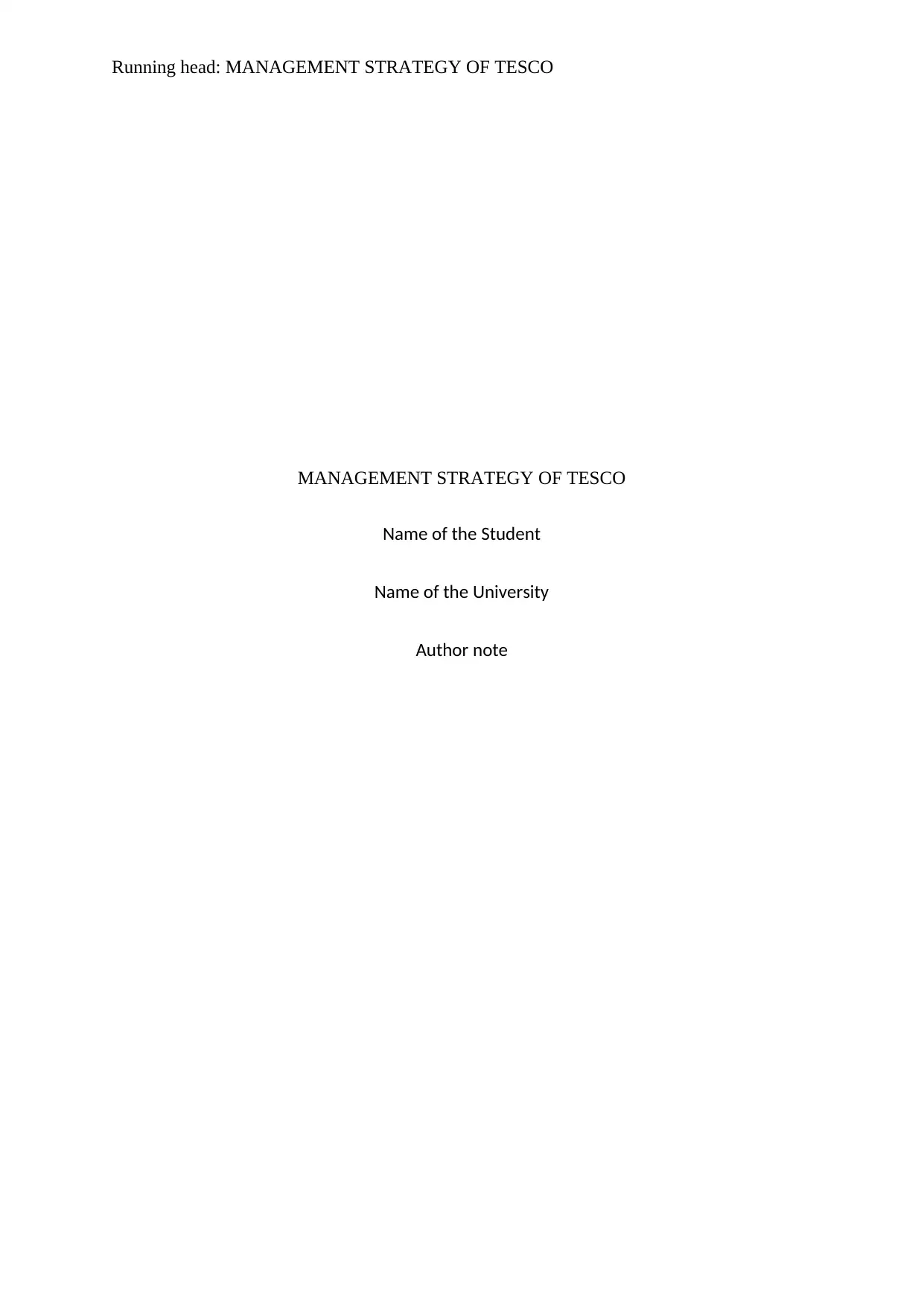
Running head: MANAGEMENT STRATEGY OF TESCO
MANAGEMENT STRATEGY OF TESCO
Name of the Student
Name of the University
Author note
MANAGEMENT STRATEGY OF TESCO
Name of the Student
Name of the University
Author note
Paraphrase This Document
Need a fresh take? Get an instant paraphrase of this document with our AI Paraphraser
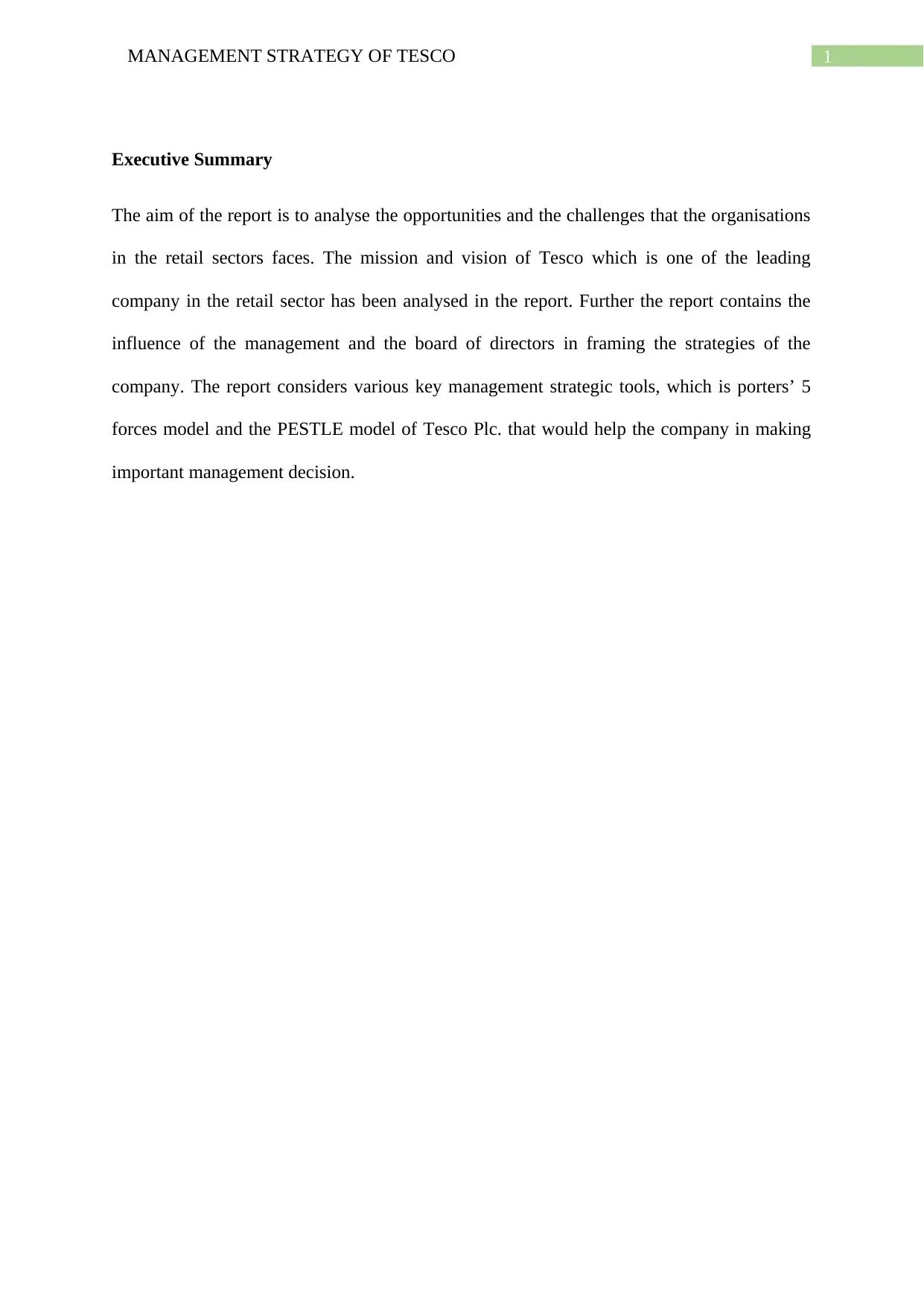
1MANAGEMENT STRATEGY OF TESCO
Executive Summary
The aim of the report is to analyse the opportunities and the challenges that the organisations
in the retail sectors faces. The mission and vision of Tesco which is one of the leading
company in the retail sector has been analysed in the report. Further the report contains the
influence of the management and the board of directors in framing the strategies of the
company. The report considers various key management strategic tools, which is porters’ 5
forces model and the PESTLE model of Tesco Plc. that would help the company in making
important management decision.
Executive Summary
The aim of the report is to analyse the opportunities and the challenges that the organisations
in the retail sectors faces. The mission and vision of Tesco which is one of the leading
company in the retail sector has been analysed in the report. Further the report contains the
influence of the management and the board of directors in framing the strategies of the
company. The report considers various key management strategic tools, which is porters’ 5
forces model and the PESTLE model of Tesco Plc. that would help the company in making
important management decision.
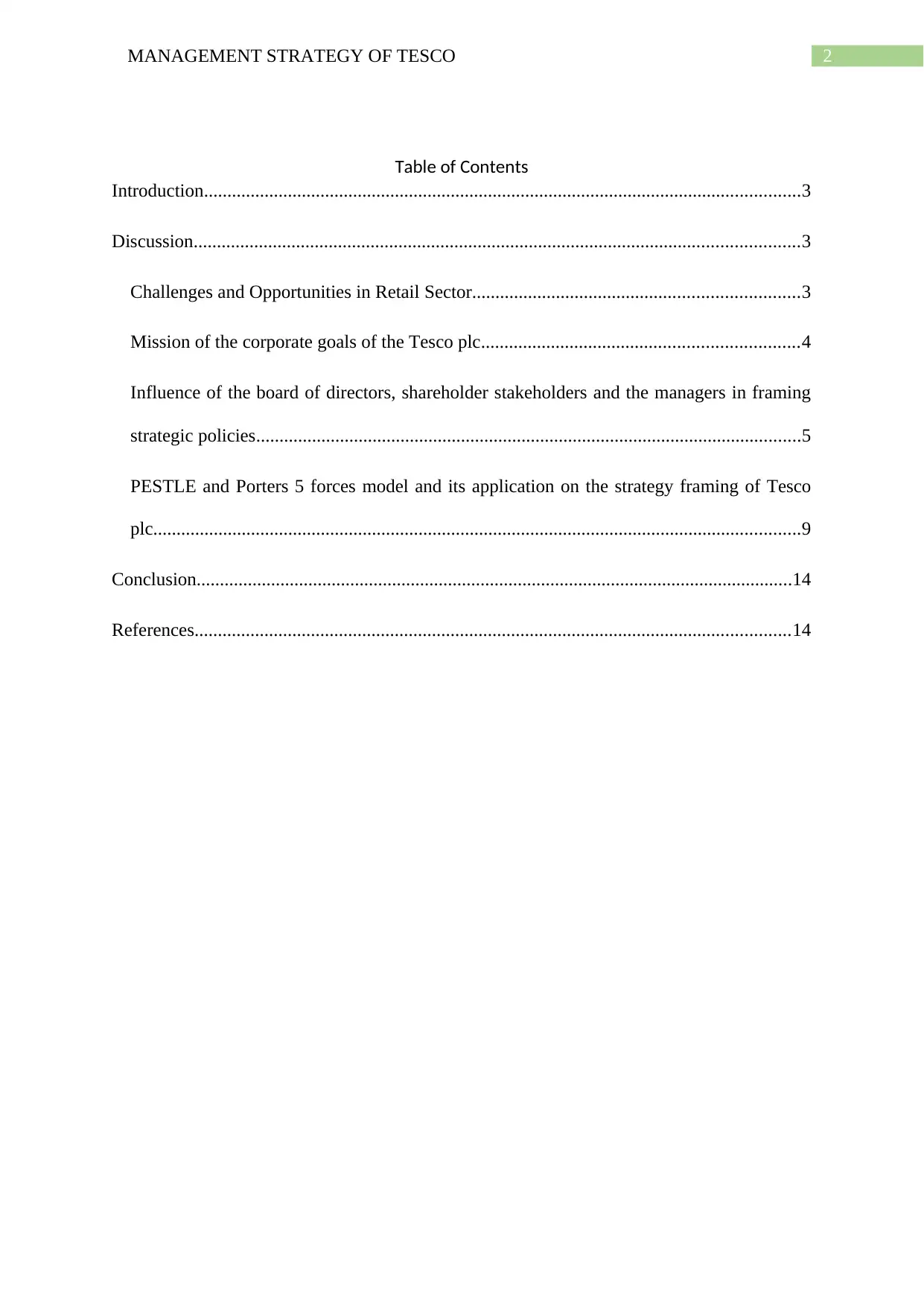
2MANAGEMENT STRATEGY OF TESCO
Table of Contents
Introduction................................................................................................................................3
Discussion..................................................................................................................................3
Challenges and Opportunities in Retail Sector......................................................................3
Mission of the corporate goals of the Tesco plc....................................................................4
Influence of the board of directors, shareholder stakeholders and the managers in framing
strategic policies.....................................................................................................................5
PESTLE and Porters 5 forces model and its application on the strategy framing of Tesco
plc...........................................................................................................................................9
Conclusion................................................................................................................................14
References................................................................................................................................14
Table of Contents
Introduction................................................................................................................................3
Discussion..................................................................................................................................3
Challenges and Opportunities in Retail Sector......................................................................3
Mission of the corporate goals of the Tesco plc....................................................................4
Influence of the board of directors, shareholder stakeholders and the managers in framing
strategic policies.....................................................................................................................5
PESTLE and Porters 5 forces model and its application on the strategy framing of Tesco
plc...........................................................................................................................................9
Conclusion................................................................................................................................14
References................................................................................................................................14
⊘ This is a preview!⊘
Do you want full access?
Subscribe today to unlock all pages.

Trusted by 1+ million students worldwide
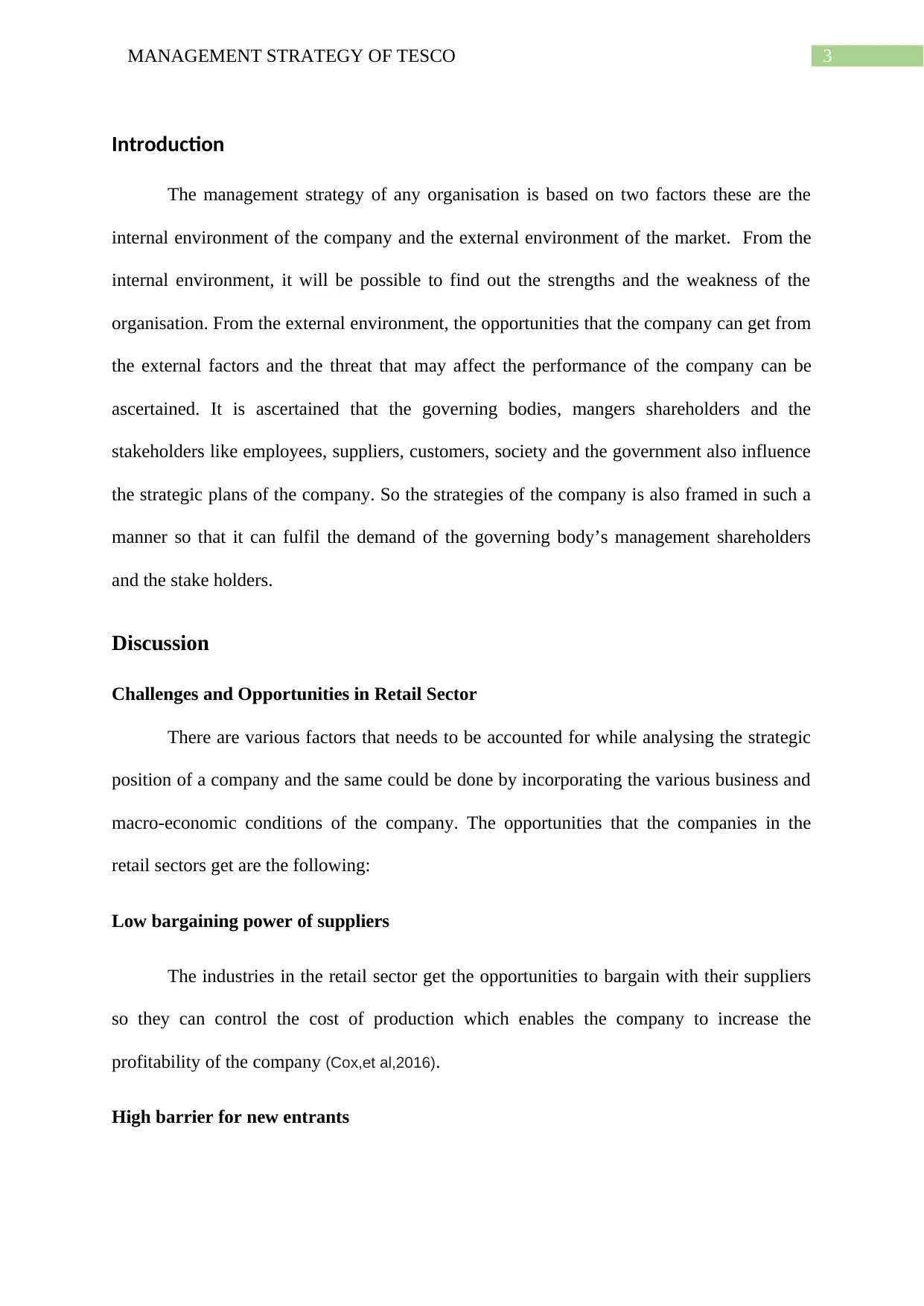
3MANAGEMENT STRATEGY OF TESCO
Introduction
The management strategy of any organisation is based on two factors these are the
internal environment of the company and the external environment of the market. From the
internal environment, it will be possible to find out the strengths and the weakness of the
organisation. From the external environment, the opportunities that the company can get from
the external factors and the threat that may affect the performance of the company can be
ascertained. It is ascertained that the governing bodies, mangers shareholders and the
stakeholders like employees, suppliers, customers, society and the government also influence
the strategic plans of the company. So the strategies of the company is also framed in such a
manner so that it can fulfil the demand of the governing body’s management shareholders
and the stake holders.
Discussion
Challenges and Opportunities in Retail Sector
There are various factors that needs to be accounted for while analysing the strategic
position of a company and the same could be done by incorporating the various business and
macro-economic conditions of the company. The opportunities that the companies in the
retail sectors get are the following:
Low bargaining power of suppliers
The industries in the retail sector get the opportunities to bargain with their suppliers
so they can control the cost of production which enables the company to increase the
profitability of the company (Cox,et al,2016).
High barrier for new entrants
Introduction
The management strategy of any organisation is based on two factors these are the
internal environment of the company and the external environment of the market. From the
internal environment, it will be possible to find out the strengths and the weakness of the
organisation. From the external environment, the opportunities that the company can get from
the external factors and the threat that may affect the performance of the company can be
ascertained. It is ascertained that the governing bodies, mangers shareholders and the
stakeholders like employees, suppliers, customers, society and the government also influence
the strategic plans of the company. So the strategies of the company is also framed in such a
manner so that it can fulfil the demand of the governing body’s management shareholders
and the stake holders.
Discussion
Challenges and Opportunities in Retail Sector
There are various factors that needs to be accounted for while analysing the strategic
position of a company and the same could be done by incorporating the various business and
macro-economic conditions of the company. The opportunities that the companies in the
retail sectors get are the following:
Low bargaining power of suppliers
The industries in the retail sector get the opportunities to bargain with their suppliers
so they can control the cost of production which enables the company to increase the
profitability of the company (Cox,et al,2016).
High barrier for new entrants
Paraphrase This Document
Need a fresh take? Get an instant paraphrase of this document with our AI Paraphraser
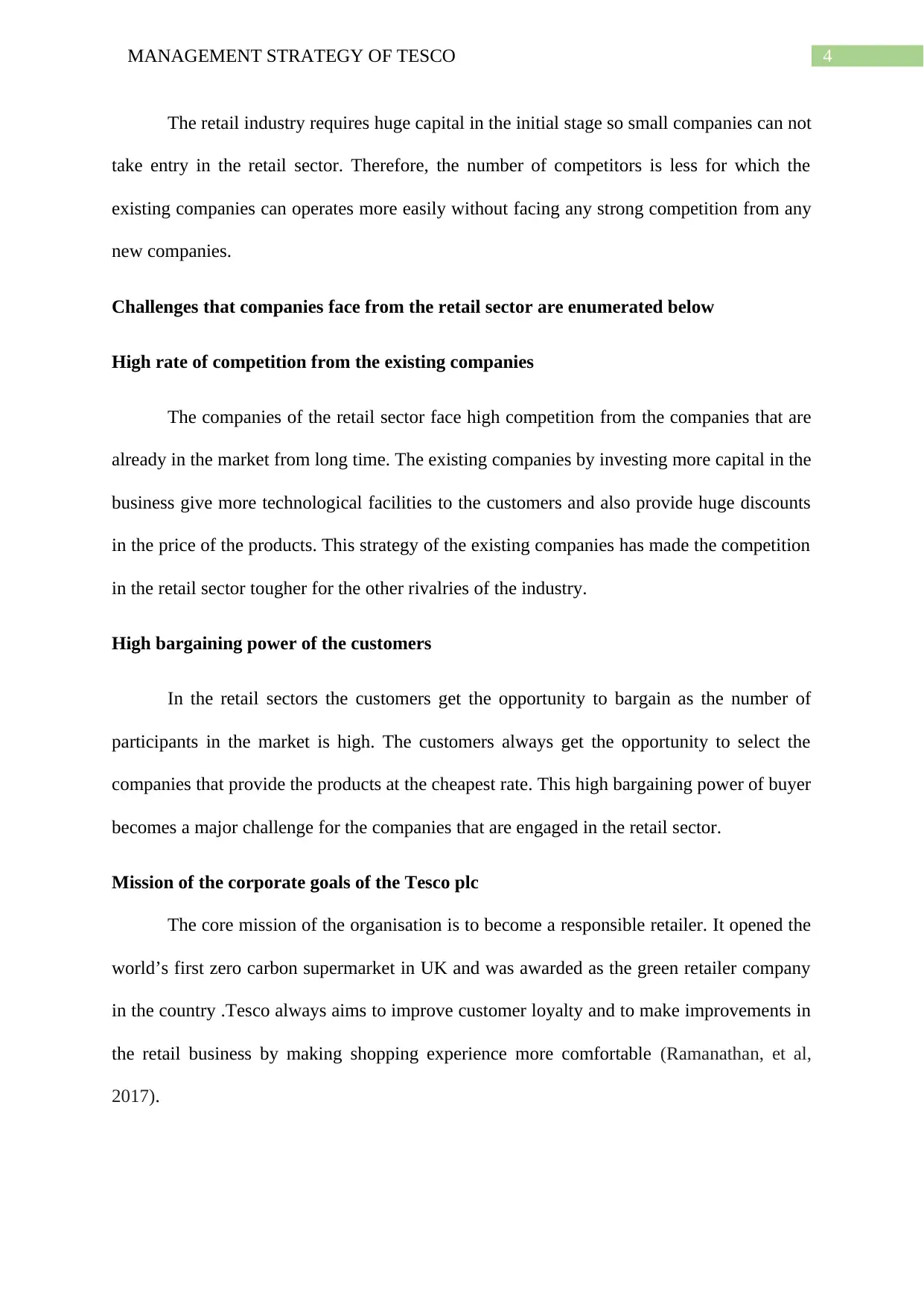
4MANAGEMENT STRATEGY OF TESCO
The retail industry requires huge capital in the initial stage so small companies can not
take entry in the retail sector. Therefore, the number of competitors is less for which the
existing companies can operates more easily without facing any strong competition from any
new companies.
Challenges that companies face from the retail sector are enumerated below
High rate of competition from the existing companies
The companies of the retail sector face high competition from the companies that are
already in the market from long time. The existing companies by investing more capital in the
business give more technological facilities to the customers and also provide huge discounts
in the price of the products. This strategy of the existing companies has made the competition
in the retail sector tougher for the other rivalries of the industry.
High bargaining power of the customers
In the retail sectors the customers get the opportunity to bargain as the number of
participants in the market is high. The customers always get the opportunity to select the
companies that provide the products at the cheapest rate. This high bargaining power of buyer
becomes a major challenge for the companies that are engaged in the retail sector.
Mission of the corporate goals of the Tesco plc
The core mission of the organisation is to become a responsible retailer. It opened the
world’s first zero carbon supermarket in UK and was awarded as the green retailer company
in the country .Tesco always aims to improve customer loyalty and to make improvements in
the retail business by making shopping experience more comfortable (Ramanathan, et al,
2017).
The retail industry requires huge capital in the initial stage so small companies can not
take entry in the retail sector. Therefore, the number of competitors is less for which the
existing companies can operates more easily without facing any strong competition from any
new companies.
Challenges that companies face from the retail sector are enumerated below
High rate of competition from the existing companies
The companies of the retail sector face high competition from the companies that are
already in the market from long time. The existing companies by investing more capital in the
business give more technological facilities to the customers and also provide huge discounts
in the price of the products. This strategy of the existing companies has made the competition
in the retail sector tougher for the other rivalries of the industry.
High bargaining power of the customers
In the retail sectors the customers get the opportunity to bargain as the number of
participants in the market is high. The customers always get the opportunity to select the
companies that provide the products at the cheapest rate. This high bargaining power of buyer
becomes a major challenge for the companies that are engaged in the retail sector.
Mission of the corporate goals of the Tesco plc
The core mission of the organisation is to become a responsible retailer. It opened the
world’s first zero carbon supermarket in UK and was awarded as the green retailer company
in the country .Tesco always aims to improve customer loyalty and to make improvements in
the retail business by making shopping experience more comfortable (Ramanathan, et al,
2017).
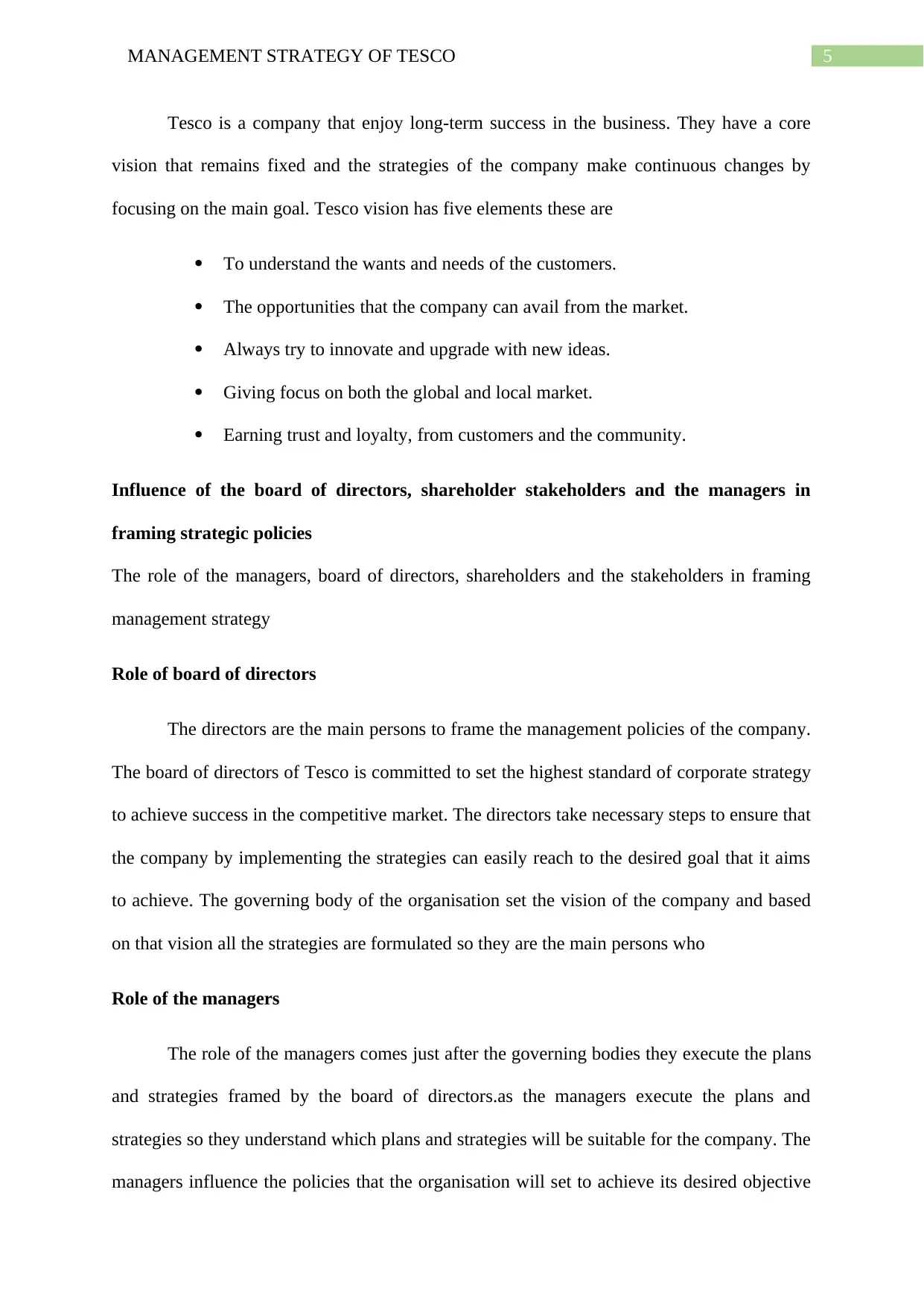
5MANAGEMENT STRATEGY OF TESCO
Tesco is a company that enjoy long-term success in the business. They have a core
vision that remains fixed and the strategies of the company make continuous changes by
focusing on the main goal. Tesco vision has five elements these are
To understand the wants and needs of the customers.
The opportunities that the company can avail from the market.
Always try to innovate and upgrade with new ideas.
Giving focus on both the global and local market.
Earning trust and loyalty, from customers and the community.
Influence of the board of directors, shareholder stakeholders and the managers in
framing strategic policies
The role of the managers, board of directors, shareholders and the stakeholders in framing
management strategy
Role of board of directors
The directors are the main persons to frame the management policies of the company.
The board of directors of Tesco is committed to set the highest standard of corporate strategy
to achieve success in the competitive market. The directors take necessary steps to ensure that
the company by implementing the strategies can easily reach to the desired goal that it aims
to achieve. The governing body of the organisation set the vision of the company and based
on that vision all the strategies are formulated so they are the main persons who
Role of the managers
The role of the managers comes just after the governing bodies they execute the plans
and strategies framed by the board of directors.as the managers execute the plans and
strategies so they understand which plans and strategies will be suitable for the company. The
managers influence the policies that the organisation will set to achieve its desired objective
Tesco is a company that enjoy long-term success in the business. They have a core
vision that remains fixed and the strategies of the company make continuous changes by
focusing on the main goal. Tesco vision has five elements these are
To understand the wants and needs of the customers.
The opportunities that the company can avail from the market.
Always try to innovate and upgrade with new ideas.
Giving focus on both the global and local market.
Earning trust and loyalty, from customers and the community.
Influence of the board of directors, shareholder stakeholders and the managers in
framing strategic policies
The role of the managers, board of directors, shareholders and the stakeholders in framing
management strategy
Role of board of directors
The directors are the main persons to frame the management policies of the company.
The board of directors of Tesco is committed to set the highest standard of corporate strategy
to achieve success in the competitive market. The directors take necessary steps to ensure that
the company by implementing the strategies can easily reach to the desired goal that it aims
to achieve. The governing body of the organisation set the vision of the company and based
on that vision all the strategies are formulated so they are the main persons who
Role of the managers
The role of the managers comes just after the governing bodies they execute the plans
and strategies framed by the board of directors.as the managers execute the plans and
strategies so they understand which plans and strategies will be suitable for the company. The
managers influence the policies that the organisation will set to achieve its desired objective
⊘ This is a preview!⊘
Do you want full access?
Subscribe today to unlock all pages.

Trusted by 1+ million students worldwide
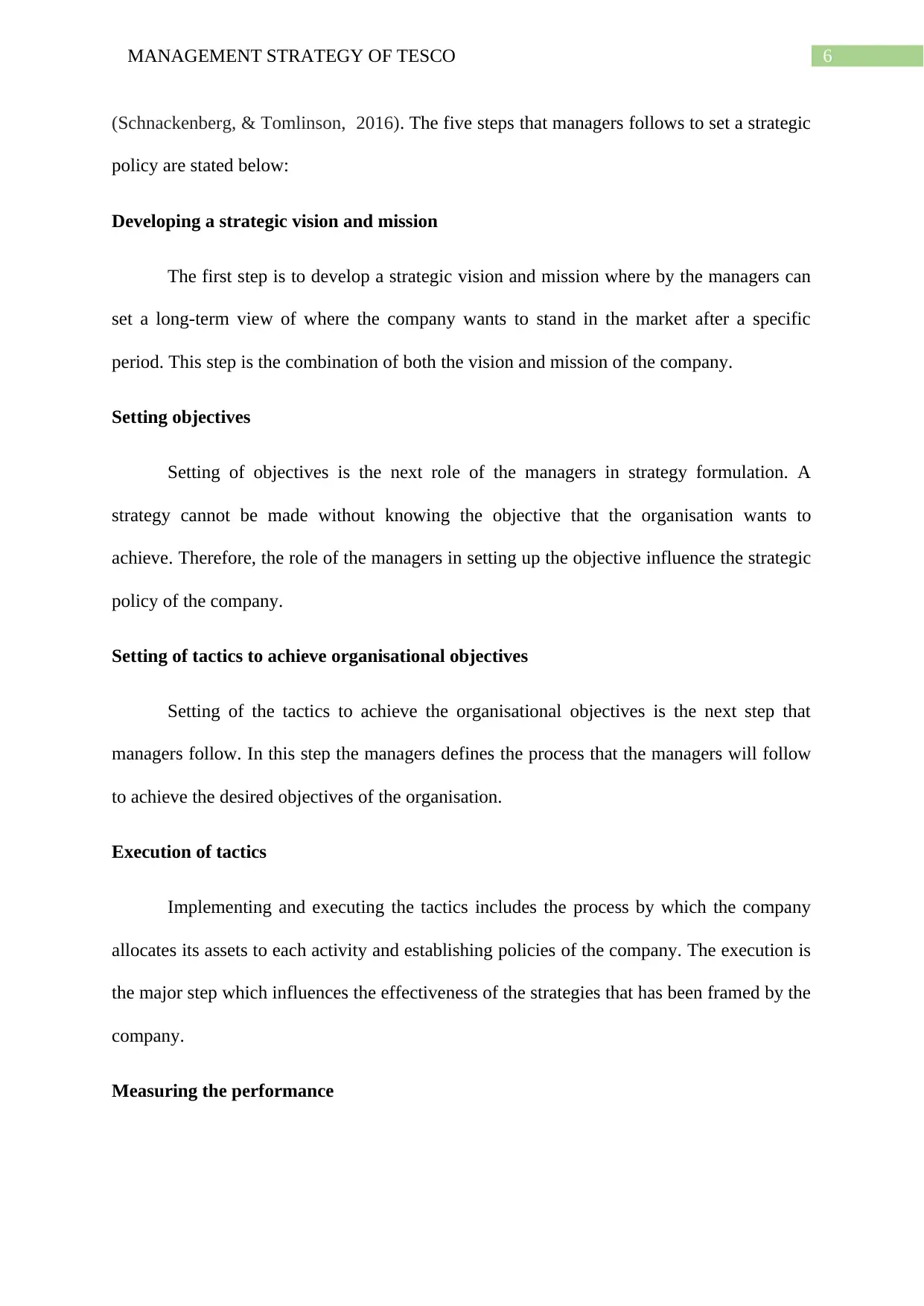
6MANAGEMENT STRATEGY OF TESCO
(Schnackenberg, & Tomlinson, 2016). The five steps that managers follows to set a strategic
policy are stated below:
Developing a strategic vision and mission
The first step is to develop a strategic vision and mission where by the managers can
set a long-term view of where the company wants to stand in the market after a specific
period. This step is the combination of both the vision and mission of the company.
Setting objectives
Setting of objectives is the next role of the managers in strategy formulation. A
strategy cannot be made without knowing the objective that the organisation wants to
achieve. Therefore, the role of the managers in setting up the objective influence the strategic
policy of the company.
Setting of tactics to achieve organisational objectives
Setting of the tactics to achieve the organisational objectives is the next step that
managers follow. In this step the managers defines the process that the managers will follow
to achieve the desired objectives of the organisation.
Execution of tactics
Implementing and executing the tactics includes the process by which the company
allocates its assets to each activity and establishing policies of the company. The execution is
the major step which influences the effectiveness of the strategies that has been framed by the
company.
Measuring the performance
(Schnackenberg, & Tomlinson, 2016). The five steps that managers follows to set a strategic
policy are stated below:
Developing a strategic vision and mission
The first step is to develop a strategic vision and mission where by the managers can
set a long-term view of where the company wants to stand in the market after a specific
period. This step is the combination of both the vision and mission of the company.
Setting objectives
Setting of objectives is the next role of the managers in strategy formulation. A
strategy cannot be made without knowing the objective that the organisation wants to
achieve. Therefore, the role of the managers in setting up the objective influence the strategic
policy of the company.
Setting of tactics to achieve organisational objectives
Setting of the tactics to achieve the organisational objectives is the next step that
managers follow. In this step the managers defines the process that the managers will follow
to achieve the desired objectives of the organisation.
Execution of tactics
Implementing and executing the tactics includes the process by which the company
allocates its assets to each activity and establishing policies of the company. The execution is
the major step which influences the effectiveness of the strategies that has been framed by the
company.
Measuring the performance
Paraphrase This Document
Need a fresh take? Get an instant paraphrase of this document with our AI Paraphraser
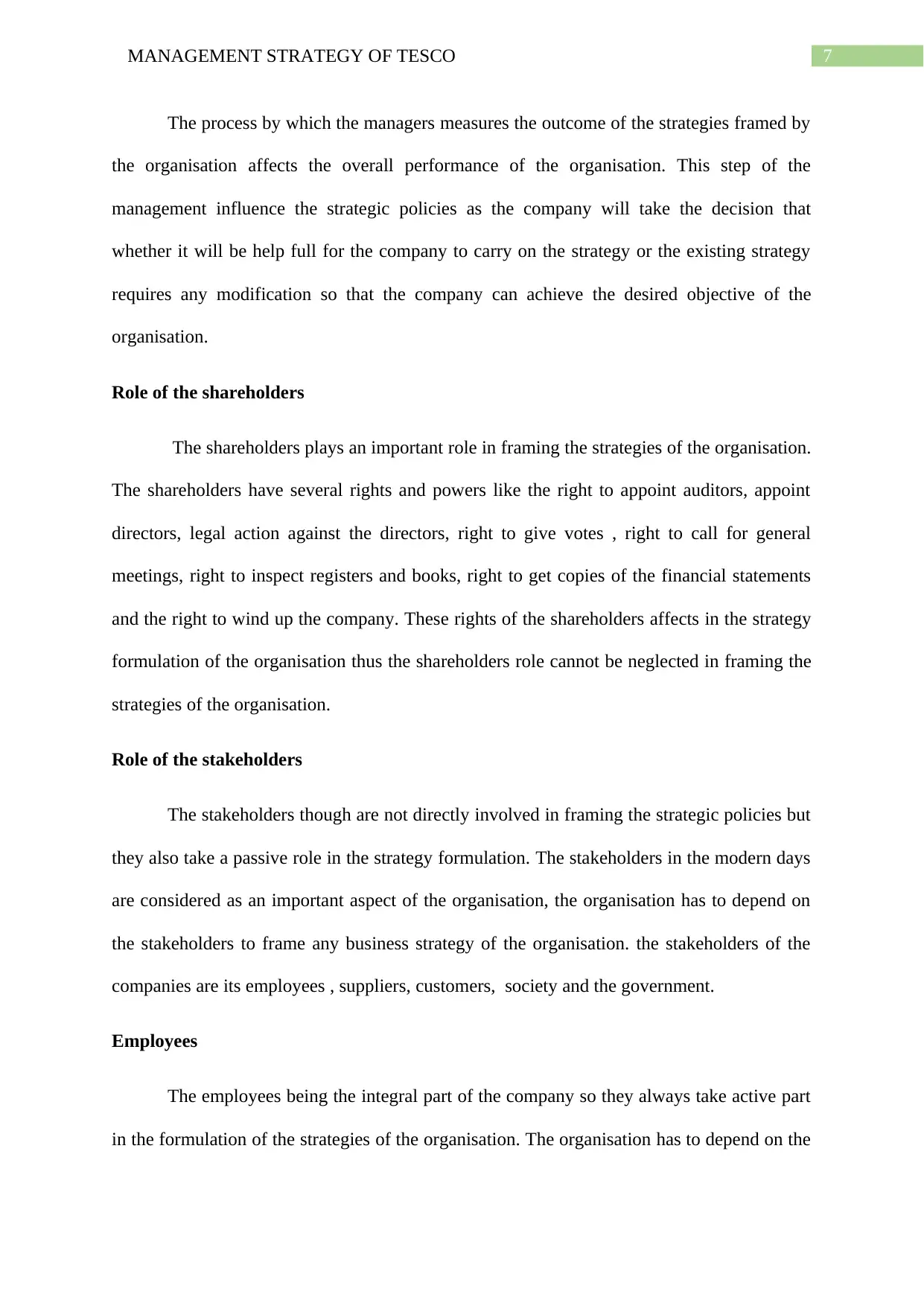
7MANAGEMENT STRATEGY OF TESCO
The process by which the managers measures the outcome of the strategies framed by
the organisation affects the overall performance of the organisation. This step of the
management influence the strategic policies as the company will take the decision that
whether it will be help full for the company to carry on the strategy or the existing strategy
requires any modification so that the company can achieve the desired objective of the
organisation.
Role of the shareholders
The shareholders plays an important role in framing the strategies of the organisation.
The shareholders have several rights and powers like the right to appoint auditors, appoint
directors, legal action against the directors, right to give votes , right to call for general
meetings, right to inspect registers and books, right to get copies of the financial statements
and the right to wind up the company. These rights of the shareholders affects in the strategy
formulation of the organisation thus the shareholders role cannot be neglected in framing the
strategies of the organisation.
Role of the stakeholders
The stakeholders though are not directly involved in framing the strategic policies but
they also take a passive role in the strategy formulation. The stakeholders in the modern days
are considered as an important aspect of the organisation, the organisation has to depend on
the stakeholders to frame any business strategy of the organisation. the stakeholders of the
companies are its employees , suppliers, customers, society and the government.
Employees
The employees being the integral part of the company so they always take active part
in the formulation of the strategies of the organisation. The organisation has to depend on the
The process by which the managers measures the outcome of the strategies framed by
the organisation affects the overall performance of the organisation. This step of the
management influence the strategic policies as the company will take the decision that
whether it will be help full for the company to carry on the strategy or the existing strategy
requires any modification so that the company can achieve the desired objective of the
organisation.
Role of the shareholders
The shareholders plays an important role in framing the strategies of the organisation.
The shareholders have several rights and powers like the right to appoint auditors, appoint
directors, legal action against the directors, right to give votes , right to call for general
meetings, right to inspect registers and books, right to get copies of the financial statements
and the right to wind up the company. These rights of the shareholders affects in the strategy
formulation of the organisation thus the shareholders role cannot be neglected in framing the
strategies of the organisation.
Role of the stakeholders
The stakeholders though are not directly involved in framing the strategic policies but
they also take a passive role in the strategy formulation. The stakeholders in the modern days
are considered as an important aspect of the organisation, the organisation has to depend on
the stakeholders to frame any business strategy of the organisation. the stakeholders of the
companies are its employees , suppliers, customers, society and the government.
Employees
The employees being the integral part of the company so they always take active part
in the formulation of the strategies of the organisation. The organisation has to depend on the
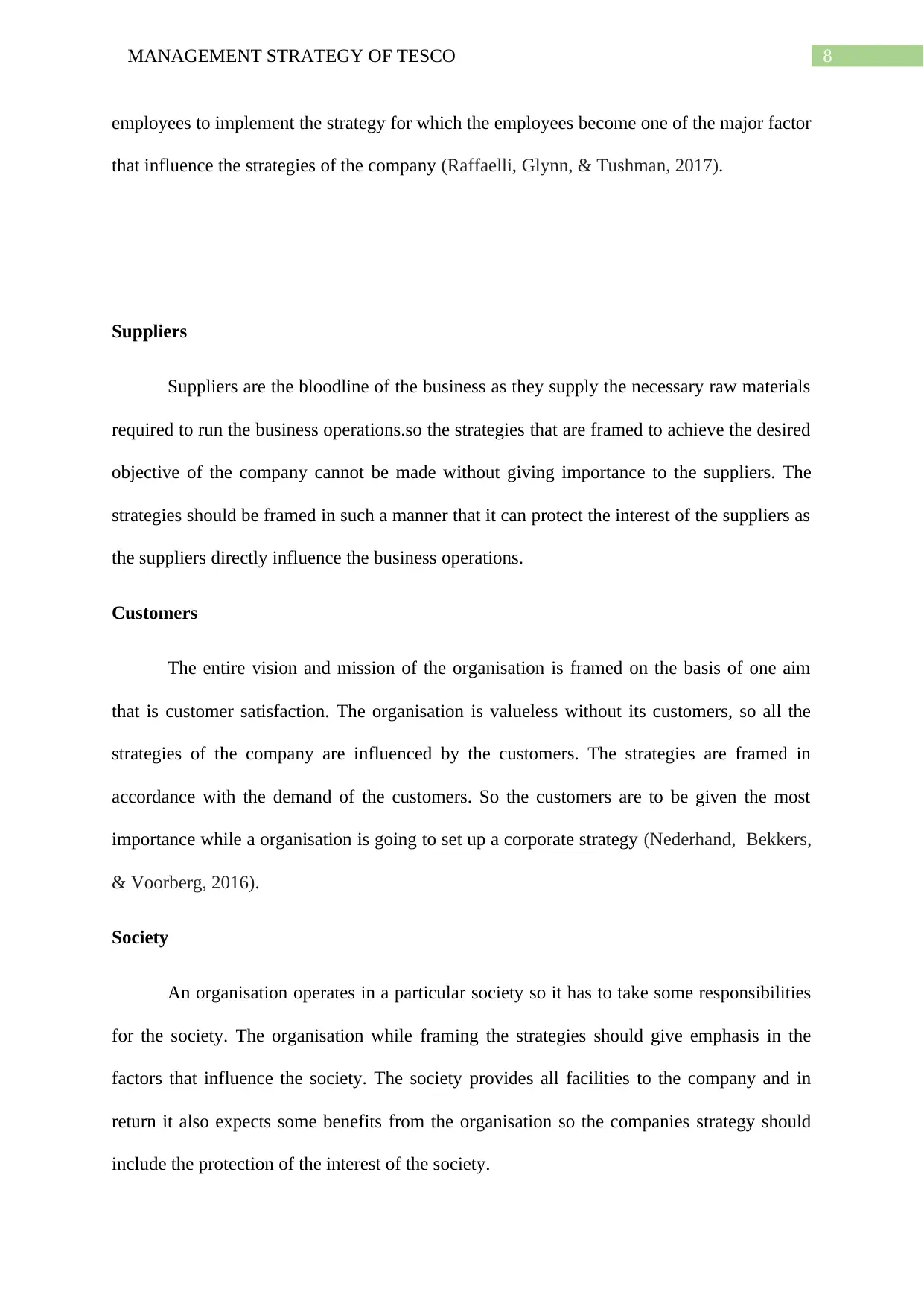
8MANAGEMENT STRATEGY OF TESCO
employees to implement the strategy for which the employees become one of the major factor
that influence the strategies of the company (Raffaelli, Glynn, & Tushman, 2017).
Suppliers
Suppliers are the bloodline of the business as they supply the necessary raw materials
required to run the business operations.so the strategies that are framed to achieve the desired
objective of the company cannot be made without giving importance to the suppliers. The
strategies should be framed in such a manner that it can protect the interest of the suppliers as
the suppliers directly influence the business operations.
Customers
The entire vision and mission of the organisation is framed on the basis of one aim
that is customer satisfaction. The organisation is valueless without its customers, so all the
strategies of the company are influenced by the customers. The strategies are framed in
accordance with the demand of the customers. So the customers are to be given the most
importance while a organisation is going to set up a corporate strategy (Nederhand, Bekkers,
& Voorberg, 2016).
Society
An organisation operates in a particular society so it has to take some responsibilities
for the society. The organisation while framing the strategies should give emphasis in the
factors that influence the society. The society provides all facilities to the company and in
return it also expects some benefits from the organisation so the companies strategy should
include the protection of the interest of the society.
employees to implement the strategy for which the employees become one of the major factor
that influence the strategies of the company (Raffaelli, Glynn, & Tushman, 2017).
Suppliers
Suppliers are the bloodline of the business as they supply the necessary raw materials
required to run the business operations.so the strategies that are framed to achieve the desired
objective of the company cannot be made without giving importance to the suppliers. The
strategies should be framed in such a manner that it can protect the interest of the suppliers as
the suppliers directly influence the business operations.
Customers
The entire vision and mission of the organisation is framed on the basis of one aim
that is customer satisfaction. The organisation is valueless without its customers, so all the
strategies of the company are influenced by the customers. The strategies are framed in
accordance with the demand of the customers. So the customers are to be given the most
importance while a organisation is going to set up a corporate strategy (Nederhand, Bekkers,
& Voorberg, 2016).
Society
An organisation operates in a particular society so it has to take some responsibilities
for the society. The organisation while framing the strategies should give emphasis in the
factors that influence the society. The society provides all facilities to the company and in
return it also expects some benefits from the organisation so the companies strategy should
include the protection of the interest of the society.
⊘ This is a preview!⊘
Do you want full access?
Subscribe today to unlock all pages.

Trusted by 1+ million students worldwide
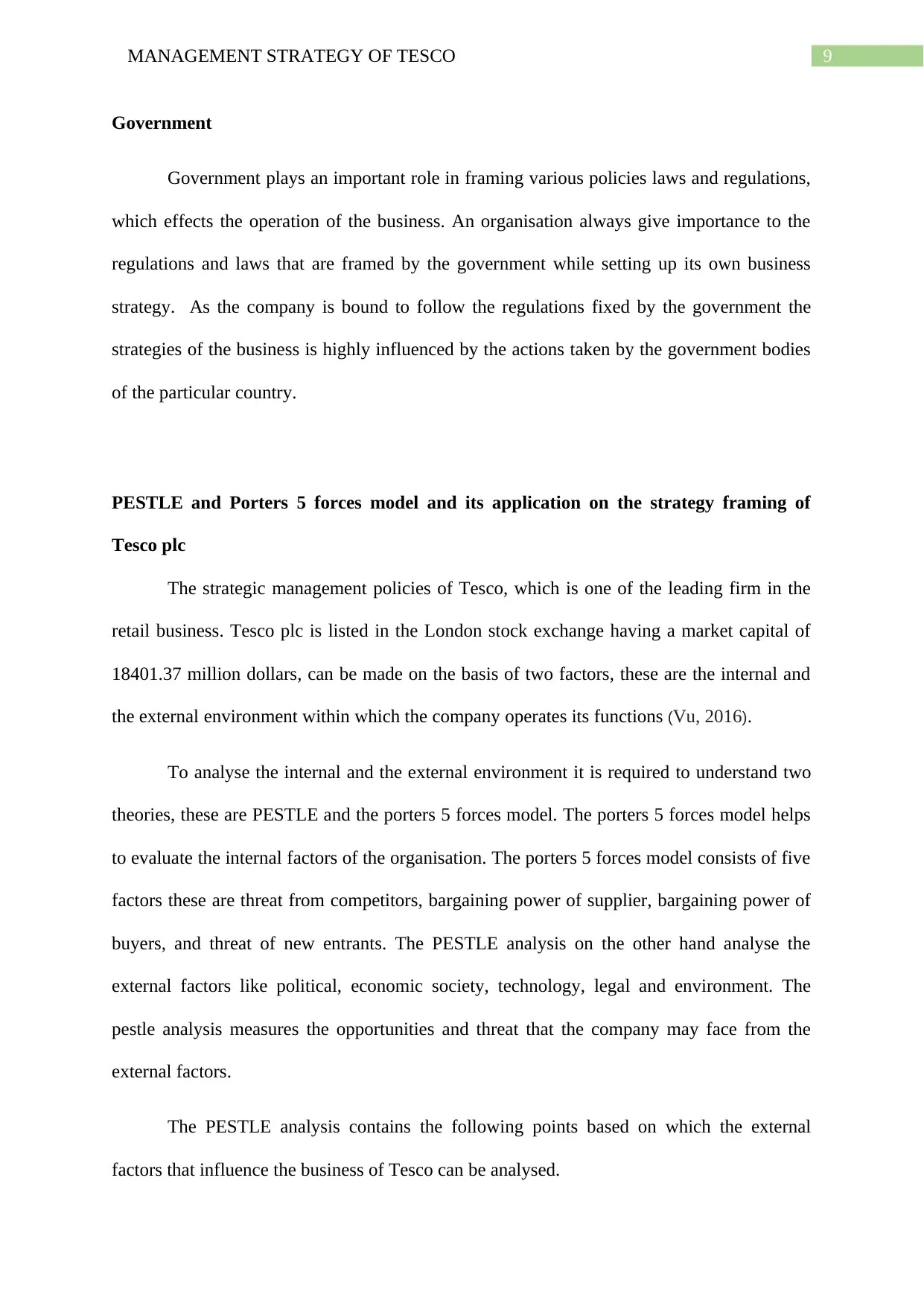
9MANAGEMENT STRATEGY OF TESCO
Government
Government plays an important role in framing various policies laws and regulations,
which effects the operation of the business. An organisation always give importance to the
regulations and laws that are framed by the government while setting up its own business
strategy. As the company is bound to follow the regulations fixed by the government the
strategies of the business is highly influenced by the actions taken by the government bodies
of the particular country.
PESTLE and Porters 5 forces model and its application on the strategy framing of
Tesco plc
The strategic management policies of Tesco, which is one of the leading firm in the
retail business. Tesco plc is listed in the London stock exchange having a market capital of
18401.37 million dollars, can be made on the basis of two factors, these are the internal and
the external environment within which the company operates its functions (Vu, 2016).
To analyse the internal and the external environment it is required to understand two
theories, these are PESTLE and the porters 5 forces model. The porters 5 forces model helps
to evaluate the internal factors of the organisation. The porters 5 forces model consists of five
factors these are threat from competitors, bargaining power of supplier, bargaining power of
buyers, and threat of new entrants. The PESTLE analysis on the other hand analyse the
external factors like political, economic society, technology, legal and environment. The
pestle analysis measures the opportunities and threat that the company may face from the
external factors.
The PESTLE analysis contains the following points based on which the external
factors that influence the business of Tesco can be analysed.
Government
Government plays an important role in framing various policies laws and regulations,
which effects the operation of the business. An organisation always give importance to the
regulations and laws that are framed by the government while setting up its own business
strategy. As the company is bound to follow the regulations fixed by the government the
strategies of the business is highly influenced by the actions taken by the government bodies
of the particular country.
PESTLE and Porters 5 forces model and its application on the strategy framing of
Tesco plc
The strategic management policies of Tesco, which is one of the leading firm in the
retail business. Tesco plc is listed in the London stock exchange having a market capital of
18401.37 million dollars, can be made on the basis of two factors, these are the internal and
the external environment within which the company operates its functions (Vu, 2016).
To analyse the internal and the external environment it is required to understand two
theories, these are PESTLE and the porters 5 forces model. The porters 5 forces model helps
to evaluate the internal factors of the organisation. The porters 5 forces model consists of five
factors these are threat from competitors, bargaining power of supplier, bargaining power of
buyers, and threat of new entrants. The PESTLE analysis on the other hand analyse the
external factors like political, economic society, technology, legal and environment. The
pestle analysis measures the opportunities and threat that the company may face from the
external factors.
The PESTLE analysis contains the following points based on which the external
factors that influence the business of Tesco can be analysed.
Paraphrase This Document
Need a fresh take? Get an instant paraphrase of this document with our AI Paraphraser
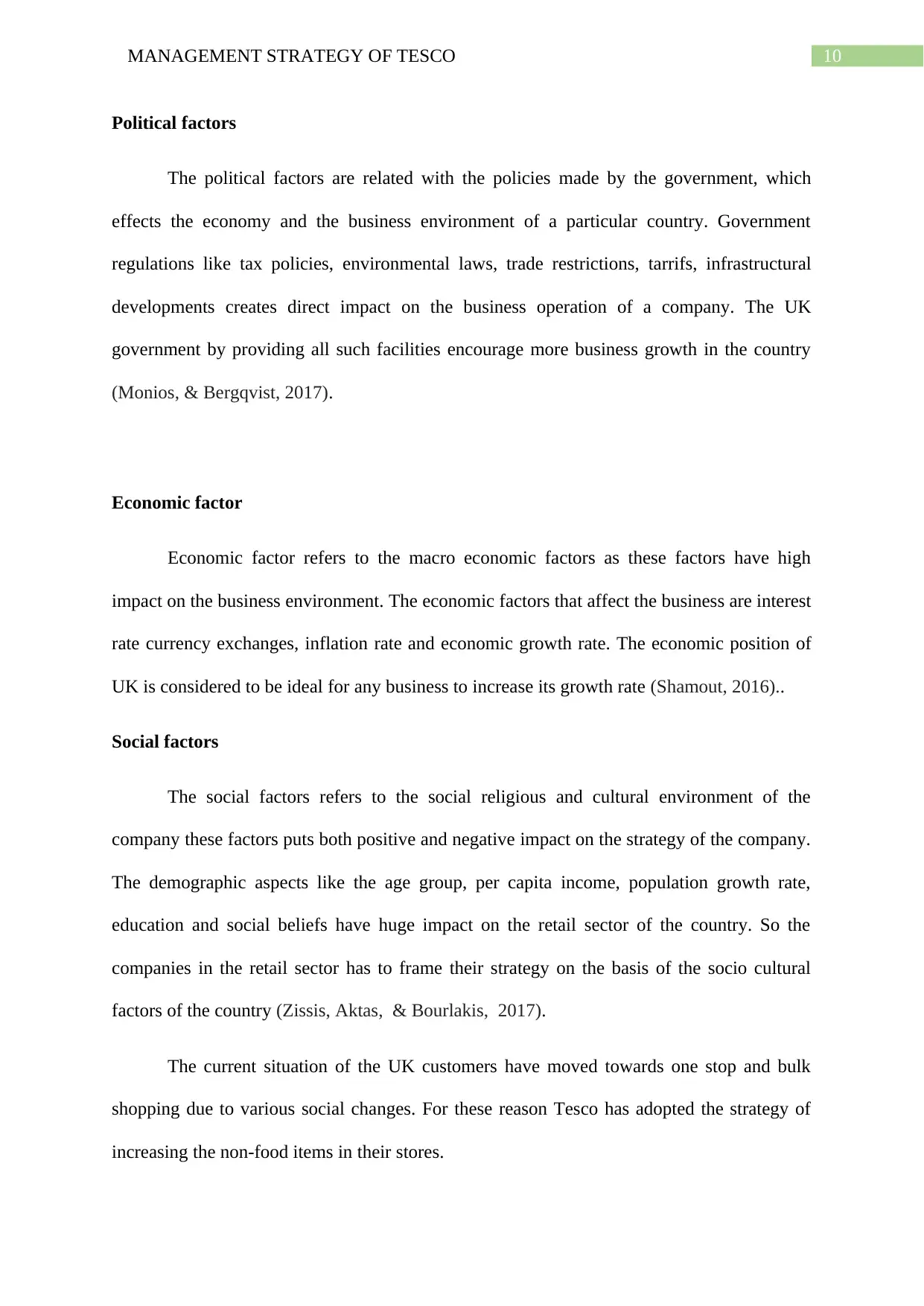
10MANAGEMENT STRATEGY OF TESCO
Political factors
The political factors are related with the policies made by the government, which
effects the economy and the business environment of a particular country. Government
regulations like tax policies, environmental laws, trade restrictions, tarrifs, infrastructural
developments creates direct impact on the business operation of a company. The UK
government by providing all such facilities encourage more business growth in the country
(Monios, & Bergqvist, 2017).
Economic factor
Economic factor refers to the macro economic factors as these factors have high
impact on the business environment. The economic factors that affect the business are interest
rate currency exchanges, inflation rate and economic growth rate. The economic position of
UK is considered to be ideal for any business to increase its growth rate (Shamout, 2016)..
Social factors
The social factors refers to the social religious and cultural environment of the
company these factors puts both positive and negative impact on the strategy of the company.
The demographic aspects like the age group, per capita income, population growth rate,
education and social beliefs have huge impact on the retail sector of the country. So the
companies in the retail sector has to frame their strategy on the basis of the socio cultural
factors of the country (Zissis, Aktas, & Bourlakis, 2017).
The current situation of the UK customers have moved towards one stop and bulk
shopping due to various social changes. For these reason Tesco has adopted the strategy of
increasing the non-food items in their stores.
Political factors
The political factors are related with the policies made by the government, which
effects the economy and the business environment of a particular country. Government
regulations like tax policies, environmental laws, trade restrictions, tarrifs, infrastructural
developments creates direct impact on the business operation of a company. The UK
government by providing all such facilities encourage more business growth in the country
(Monios, & Bergqvist, 2017).
Economic factor
Economic factor refers to the macro economic factors as these factors have high
impact on the business environment. The economic factors that affect the business are interest
rate currency exchanges, inflation rate and economic growth rate. The economic position of
UK is considered to be ideal for any business to increase its growth rate (Shamout, 2016)..
Social factors
The social factors refers to the social religious and cultural environment of the
company these factors puts both positive and negative impact on the strategy of the company.
The demographic aspects like the age group, per capita income, population growth rate,
education and social beliefs have huge impact on the retail sector of the country. So the
companies in the retail sector has to frame their strategy on the basis of the socio cultural
factors of the country (Zissis, Aktas, & Bourlakis, 2017).
The current situation of the UK customers have moved towards one stop and bulk
shopping due to various social changes. For these reason Tesco has adopted the strategy of
increasing the non-food items in their stores.
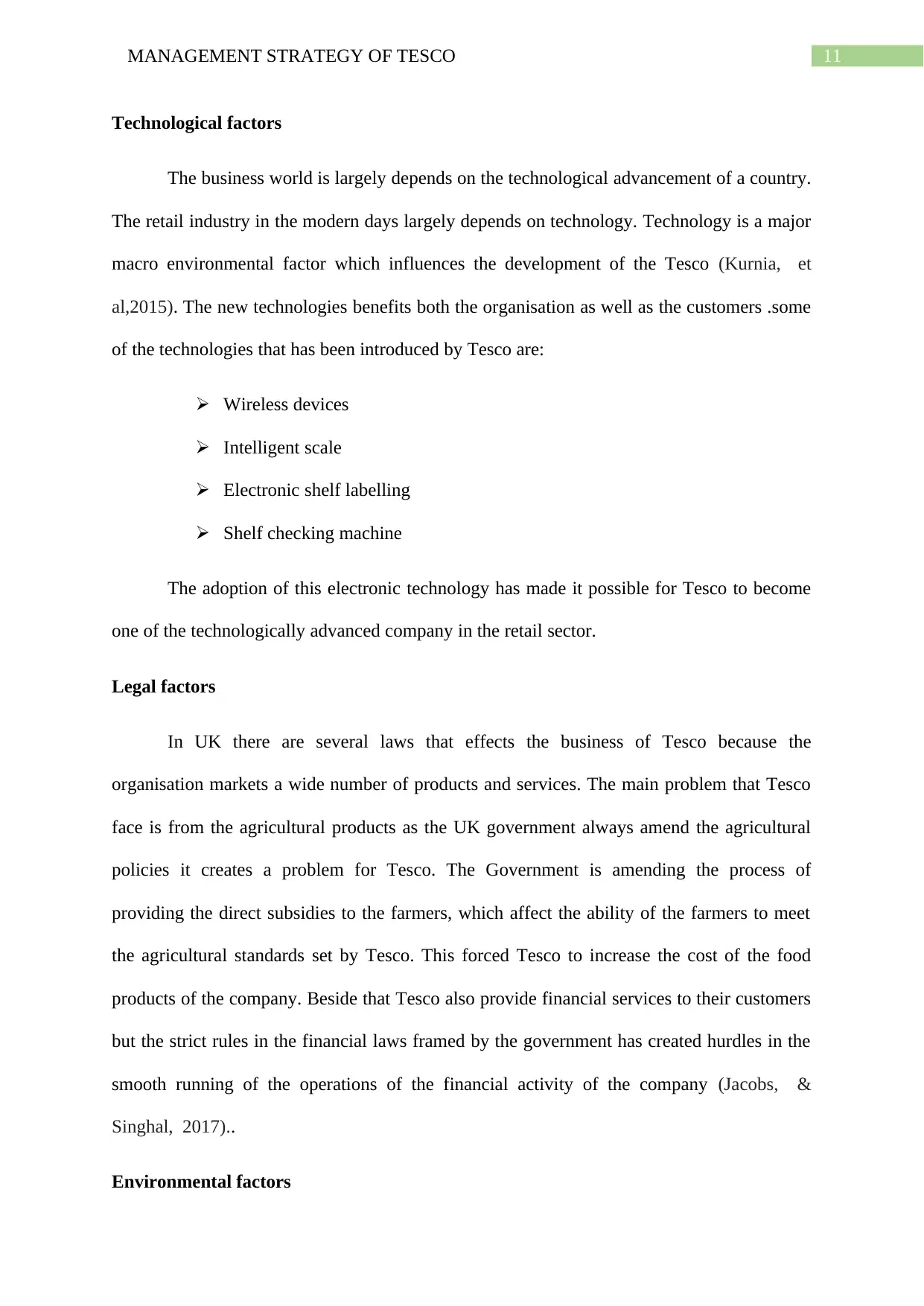
11MANAGEMENT STRATEGY OF TESCO
Technological factors
The business world is largely depends on the technological advancement of a country.
The retail industry in the modern days largely depends on technology. Technology is a major
macro environmental factor which influences the development of the Tesco (Kurnia, et
al,2015). The new technologies benefits both the organisation as well as the customers .some
of the technologies that has been introduced by Tesco are:
Wireless devices
Intelligent scale
Electronic shelf labelling
Shelf checking machine
The adoption of this electronic technology has made it possible for Tesco to become
one of the technologically advanced company in the retail sector.
Legal factors
In UK there are several laws that effects the business of Tesco because the
organisation markets a wide number of products and services. The main problem that Tesco
face is from the agricultural products as the UK government always amend the agricultural
policies it creates a problem for Tesco. The Government is amending the process of
providing the direct subsidies to the farmers, which affect the ability of the farmers to meet
the agricultural standards set by Tesco. This forced Tesco to increase the cost of the food
products of the company. Beside that Tesco also provide financial services to their customers
but the strict rules in the financial laws framed by the government has created hurdles in the
smooth running of the operations of the financial activity of the company (Jacobs, &
Singhal, 2017)..
Environmental factors
Technological factors
The business world is largely depends on the technological advancement of a country.
The retail industry in the modern days largely depends on technology. Technology is a major
macro environmental factor which influences the development of the Tesco (Kurnia, et
al,2015). The new technologies benefits both the organisation as well as the customers .some
of the technologies that has been introduced by Tesco are:
Wireless devices
Intelligent scale
Electronic shelf labelling
Shelf checking machine
The adoption of this electronic technology has made it possible for Tesco to become
one of the technologically advanced company in the retail sector.
Legal factors
In UK there are several laws that effects the business of Tesco because the
organisation markets a wide number of products and services. The main problem that Tesco
face is from the agricultural products as the UK government always amend the agricultural
policies it creates a problem for Tesco. The Government is amending the process of
providing the direct subsidies to the farmers, which affect the ability of the farmers to meet
the agricultural standards set by Tesco. This forced Tesco to increase the cost of the food
products of the company. Beside that Tesco also provide financial services to their customers
but the strict rules in the financial laws framed by the government has created hurdles in the
smooth running of the operations of the financial activity of the company (Jacobs, &
Singhal, 2017)..
Environmental factors
⊘ This is a preview!⊘
Do you want full access?
Subscribe today to unlock all pages.

Trusted by 1+ million students worldwide
1 out of 18
Related Documents
Your All-in-One AI-Powered Toolkit for Academic Success.
+13062052269
info@desklib.com
Available 24*7 on WhatsApp / Email
![[object Object]](/_next/static/media/star-bottom.7253800d.svg)
Unlock your academic potential
Copyright © 2020–2025 A2Z Services. All Rights Reserved. Developed and managed by ZUCOL.





